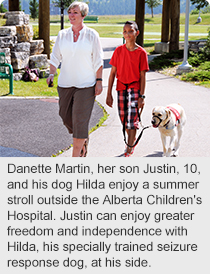
August 15, 2014
Story by Greg Harris; Photos by Paul Rotzinger and Danette Martin
Ten-year-old Justin Martin was playing hockey in his Lethbridge backyard last January when he had an epileptic seizure and went down hard. At his side, a specially trained guide dog named Hilda sounded the alarm.
“Justin had hit the ground face-first pretty hard, but Hilda responded perfectly with her beautiful bark, and his dad and I were alerted to what was going on,” says Justin’s mom, Danette.
“She’s been a great addition to the family. Justin has once again been able to experience the freedom to move about in our home and our community. He rides his bike with friends, goes to the park, plays outside, and enjoys the things he should be enjoying in his life right now.” 
Justin and Hilda, a yellow labrador specially trained as a seizure response dog, were paired in December 2013 as part of a research study based at Alberta Children’s Hospital in Calgary.
Led by pediatric neurologist Dr. Adam Kirton, the research is aimed at measuring changes in quality of life when a seizure response dog like Hilda joins a family.
“Seizure response dogs have been around for more than 10 years. Some reports suggest they can provide useful aid to people with seizures, such as summoning help when needed,” Dr. Kirton says.
“However, no one has studied whether they can help improve the quality of life for these young patients, who are sometimes isolated from their peer groups because of their medical condition.”
Seizure response dogs differ from seizure alert dogs, which may have the ability to sense the onset of a seizure moments before it actually occurs, though this is unproven with almost no research to date.
While on a visit to Children’s Hospital, Danette noticed a poster around a statue of a dog advertising for the study. “I took a picture of it and I thought, ‘We need to get this!’”
Once Justin and his family were accepted into the study, they traveled to Oakville, Ont., where they underwent extensive training with the Lions Foundation of Canada Dog Guides organization.
For three weeks Justin and Hilda worked together day and night, with Justin learning which of the basic commands he needed to use with Hilda, depending on circumstances. The training also included mock seizures, during which Hilda would be required to bark and seek out help.
Since then, Hilda has been at Justin’s side through thick and thin: at school, at Alberta Children’s Hospital in Calgary for three neurosurgeries, and every night together in bed.
“I have to wear ear plugs because she snores like a freight train,” Justin says. “But she’s given me my room back. My mom doesn’t have to sleep in the same room anymore and I have more independence.”
Justin began having unexplained seizures when he was eight years old. In one episode his parents took him to hospital in Lethbridge and he began seizing while being triaged. The seizures continued and he was subsequently flown to Alberta Children’s Hospital.
Since then he’s been on numerous medications to control the seizures, as underwent three neurosurgeries to pinpoint and neutralize the areas in his brain causing them.
“We are very happy to say that he has now been seizure-free since May 21,” says Danette.
“Justin has remarkable self-esteem and we are thankful that with the aid of a very loving and well-trained dog, he continues to exude this esteem.
“We know that if he were to have a seizure, Hilda would alert us or others around him. Her bark is one that demands attention. Justin wears appropriate ID and, with her vest, we feel confident people in our community would come to his aid should he require it.”